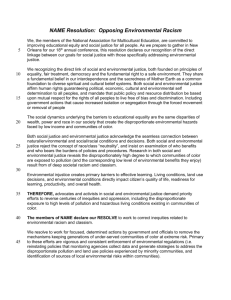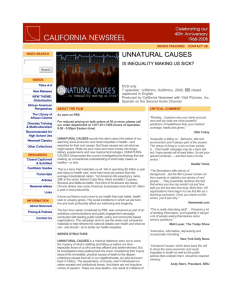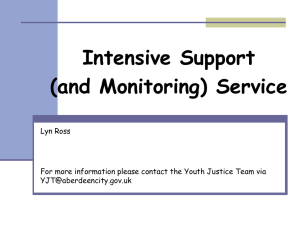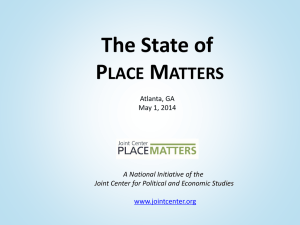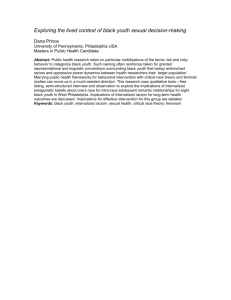Unnatural Causes Planning Handout.pub
advertisement
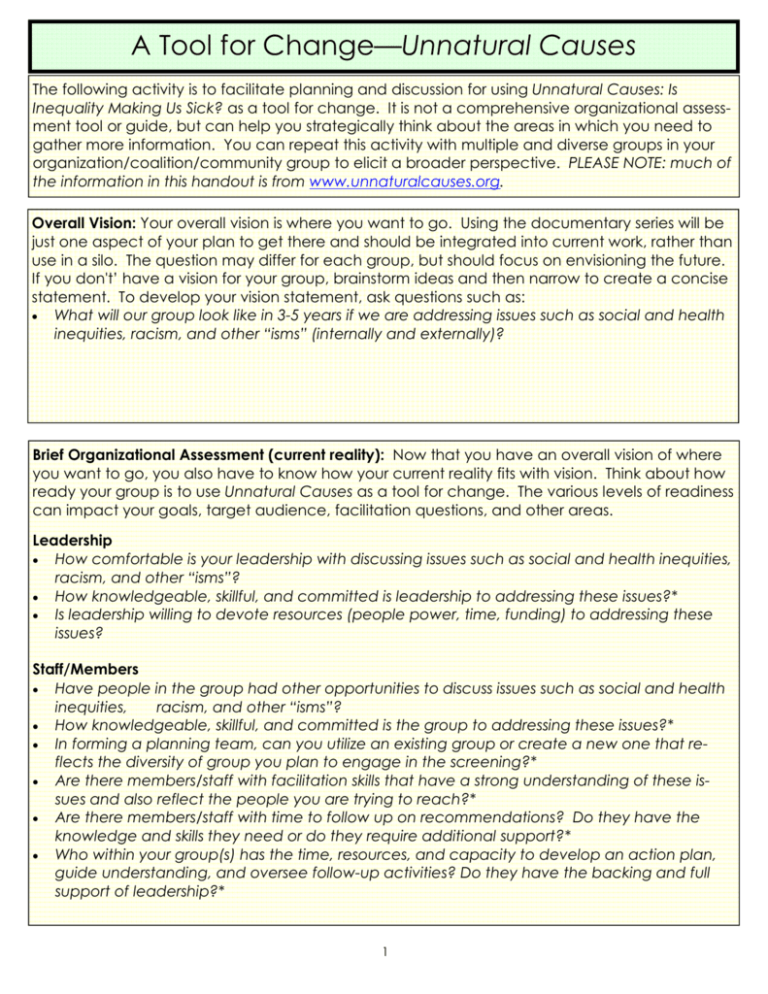
A Tool for Change—Unnatural Causes The following activity is to facilitate planning and discussion for using Unnatural Causes: Is Inequality Making Us Sick? as a tool for change. It is not a comprehensive organizational assessment tool or guide, but can help you strategically think about the areas in which you need to gather more information. You can repeat this activity with multiple and diverse groups in your organization/coalition/community group to elicit a broader perspective. PLEASE NOTE: much of the information in this handout is from www.unnaturalcauses.org. Overall Vision: Your overall vision is where you want to go. Using the documentary series will be just one aspect of your plan to get there and should be integrated into current work, rather than use in a silo. The question may differ for each group, but should focus on envisioning the future. If you don't’ have a vision for your group, brainstorm ideas and then narrow to create a concise statement. To develop your vision statement, ask questions such as: • What will our group look like in 3-5 years if we are addressing issues such as social and health inequities, racism, and other “isms” (internally and externally)? Brief Organizational Assessment (current reality): Now that you have an overall vision of where you want to go, you also have to know how your current reality fits with vision. Think about how ready your group is to use Unnatural Causes as a tool for change. The various levels of readiness can impact your goals, target audience, facilitation questions, and other areas. Leadership • How comfortable is your leadership with discussing issues such as social and health inequities, racism, and other “isms”? • How knowledgeable, skillful, and committed is leadership to addressing these issues?* • Is leadership willing to devote resources (people power, time, funding) to addressing these issues? Staff/Members • Have people in the group had other opportunities to discuss issues such as social and health inequities, racism, and other “isms”? • How knowledgeable, skillful, and committed is the group to addressing these issues?* • In forming a planning team, can you utilize an existing group or create a new one that reflects the diversity of group you plan to engage in the screening?* • Are there members/staff with facilitation skills that have a strong understanding of these issues and also reflect the people you are trying to reach?* • Are there members/staff with time to follow up on recommendations? Do they have the knowledge and skills they need or do they require additional support?* • Who within your group(s) has the time, resources, and capacity to develop an action plan, guide understanding, and oversee follow-up activities? Do they have the backing and full support of leadership?* 1 Organization/Group • How do your existing programs, policies, and partnerships address issues such as social and health inequities, racism, and other “isms”? • Does your organization/group provide the time and space for people to learn about the issues? • Does your organization/group provide opportunities for cross-divisional work on these issues? Social & Political Climate • What’s happening outside your organization/group that could advance or hinder your work on these issues?* • How can you tap into outside resources or momentum to enhance your work?* Leadership Staff Organization Social & Political Climate Strategic Goals: Based on your vision of where you want to go and your brief organizational assessment, what are the next steps you can take using the documentary series? This is a key step. Are you trying to: • open up a space for dialogue? • educate to move towards changing policies or programs? • gather information or recommendations? • build capacity to achieve a specific goal? • improve relationships? • build a critical mass for action? • organize a planning group that can carry this work forward? • Engage staff, community residents, or other organizations? • other ideas? State your goal with a strong action verb (e.g. Motivate my neighborhood group to take action on a local issue). 2 Target Audience: It’s important to know your target audience so you can plan an engaging way to use the documentary series. • To achieve your goals, what audiences do you need to target (internal or external)? • What level of understanding might they have about these issues? • If showing within an organization: • Should viewing the documentary be voluntary or mandatory? • Will viewing audiences be mixed both by division/team (e.g. separate or mixed viewings for divisions/programs) and by position (e.g. separate or mixed viewings for management and other staff)? Will you include community residents with staff or have separate viewings? • What other issues might impact the target audience (e.g. conflicts might play out in the discussion) Facilitation Team: Even an experienced facilitator with plenty of time to prepare cannot anticipate what will arise in discussing issues such as social and health inequities, racism, and other “isms.” What can be done to prepare and support facilitators? • Are there people who are skilled in facilitation? Do they match the diversity of those you are engaging in the screening? If not, are there trainings or resources that can help the people planning the screening become better facilitators? • Are the facilitators experienced in discussing issues such as social and health inequities, racism, and other “isms”? If not, are there trainings or resources that can help them understand and discuss these issues? • Are there facilitators that can engage people while remaining neutral and nonjudgmental? • What other support might facilitators need? 3 Choosing an episode: Which episode will help you reach your goal? Which episode might resonate with your group/organization? Which episode presents the message your are trying to discuss in the clearest way? When the Bough Breaks (29 min.) Can racism become embedded in the body and affect birth outcomes? Becoming American (29 min.) Latino immigrants arrive healthy, so why don’t they stay that way? In Sickness and In Wealth (56 min.) How does the distribution of power, wealth and resources shape opportunities for health? Bad Sugar (29 min.) What are the connections between diabetes, oppression, and empowerment in two Native American communities? Place Matters (29 min.) Why is your street address such a strong predictor of your health? (This episode is available as a stand-alone DVD with English, Lao, Hmong, Vietnamese, Mandarin and Cantonese audio, as well as English and Mandarin subtitles.) Collateral Damage (29 min.) How do Marshall Islanders pay for globalization and U.S. military policy with their health? Not Just a Paycheck (30 min.) Why do layoffs take such a huge toll in Michigan but cause hardly a ripple in Sweden? Facilitation Questions: It is always helpful to work with a team or get feedback from a diverse group on the questions. When facilitating , starting with easier questions or answering questions in partners first can help ensure that everyone participates in large group discussions. For example, you may want to focus on initial reactions or feelings before asking a harder question about next steps or decisions. 4 Logistics: • Is there a key person that can coordinate logistics (email reminders, booking locations, making copies, etc.)? • What dates/times/locations work best for your target audience? • Do you have a budget for providing food or coffee/tea? • Could the planners bring in food to share? • If showing within an organization: • Will leadership ensure that staff are not penalized (formally or informally) for taking time off their normal duties to attend? • If community members are coming: • Can you provide child care and transportation? • Are their local small businesses you can use to provide these services and food? • What areas do you want to reach out to? Who can help you with outreach? • Are there things you want to give to participants (handouts, information, incentives?) If so, what languages do they need to be in? Considerations for Long-Term Commitment: • After the initial viewing(s), is there time/space/commitment to conduct follow-up? • If there is a person or group willing to be the point for coordinating next steps? • Could addressing issues such as social and health inequities, racism, and other “isms” be integrated into other projects, teams, or meetings? • Could other projects or events become an obstacle for addressing issues such as social and health inequities, racism, and other “isms.” (e.g. large upcoming projects that will take away time from the planning group; an office move that will split up staff, etc.)? 5 Next Steps: • Based on what you discussed today, what are you next steps? • What can you do within the next week to keep the momentum going? • Within the next month? • Who or what could help you accomplish this? * Questions marked with * have been adapted from the Unnatural Causes action toolkit (http://www.unnaturalcauses.org/download_toolkit.php). Contact Information Alexandra Desautels (510) 208-1235 alexandra.desautels@acgov.org www.acphd.org Katherine Schaff (510) 267-3239 katherine.schaff@acgov.org www.acphd.org 6
